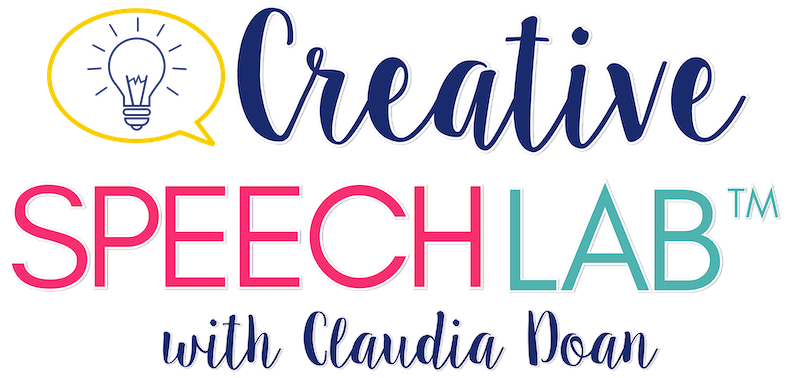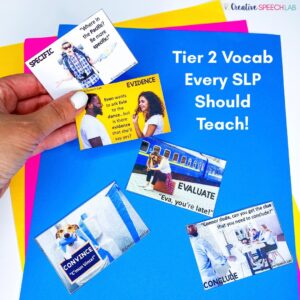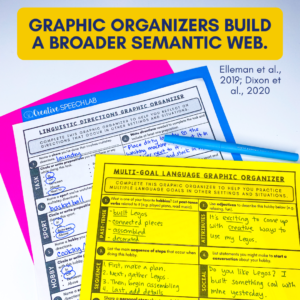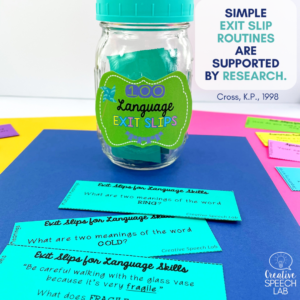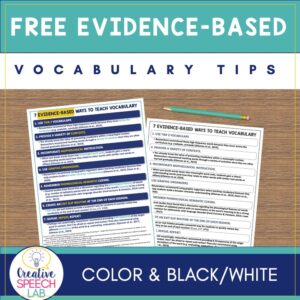You probably have some favorite vocabulary activities you find helpful for your students. (Just the fact that you’re an SLP means that you walk into every session with an in-depth understanding of words and language!)
That being said, there may be some students you find yourself worrying about. Maybe they’re feeling lost in class or have difficulty internalizing the vocabulary around them despite your best efforts. You wonder how this will affect them academically and in the big picture of their lives.
It can sometimes feel overwhelming to search for academic journal articles to find the answer. (Lucky for you, I’ve done that!)
Here’s what the research has to say about providing effective vocabulary instruction.
1. Use Tier 2 Vocabulary
WHAT is Tier 2 Vocabulary again?
Tier 2 vocabulary consists of high frequency words that tend to occur across the curriculum (e.g. evaluate, conclude).
Tier 1 vocabulary is comprised of everyday words (e.g. ball) that are more commonly used in early intervention while Tier 3 vocabulary includes less frequently occurring, domain-specific words (e.g. photosynthesis).
WHY Tier 2 Vocabulary?
Researchers describe this subset of vocabulary as having “high utility because they are useful across multiple contexts” (Elleman et al., 2019).
WHERE can I find a list of Tier 2 words?
For starters, here are my 5 favorite Tier 2 words because they occur in so many places across the curriculum.
- Evaluate
- Specific
- Conclude
- Convince
- Evidence
If you’d like to see an organized list of my top 21 Tier 2 words along with all of my research-based units for teaching them, take a closer look HERE.
2. Provide a variety of contexts
As an SLP, you already know the value of presenting vocabulary within a meaningful context. Researchers recommend taking it one step further by teaching Tier 2 vocabulary through a variety of activities since learning and internalizing words (and all of their nuances) can occur gradually.
Specifically, studies show that it’s beneficial to use “multiple exposures in rich contexts and use a variety of activities for instruction” (Elleman et al., 2019).
HOW do I provide a variety of contexts for each word?
This may feel like a labor-intensive undertaking, but it really doesn’t have to be!
Here are a few simple tips:
- Grab assignments from a variety of classes and highlight the Tier 2 words you find there. (The beauty of this subset of vocabulary is that it occurs across the curriculum!)
- Make up sentences or, better yet, a story with the word. Then make personal connections to it. Here is an example (and it’s for the Tier 2 word “context,” which I thought would be fitting!)
Ever notice how a single multiple meaning word allows you to explore a wide variety of contexts? I always feel like multiple meaning lessons can be so rich and that they help to facilitate semantic mapping!
3. Morphology Matters
This just makes total sense, right?
Whenever you break words down into meaningful word units, students gain a clearer understanding of the word (and how it relates to other words with similar root words or affixes) (Elleman et al, 2019).
That’s why I incorporate morphology into my Tier 2 instruction and created handouts for staff and families displaying root words.
4. Graphic Organizers Help!
Who doesn’t love a graphic organizers? Researchers recommend using them when teaching vocabulary because they help students build a broader semantic understanding.
Graphic organizers for speech and language skills also assist in the formation of a semantic web!
Why is semantic mapping important?
As you know, vocabulary words are not learned in isolation. Rather, each word is inextricably linked to other words. With this in mind, research supports the examination of how target words relate to other vocabulary through the use of graphic organizers and group discussions. Specifically, the creation of word webs and a discussion of synonyms and antonyms can help form a well-rounded semantic network.
(Elleman et al., 2019; Dixon et al., 2020)
5. Phonological-Semantic Cueing (one of my FAVORITES!)
You may be wondering why this is one of my favorites. Well, I love creating mnemonics for my students with this research in mind!
In the example below, I’ve identified the phonological components of the the Tier 2 word “evidence” and added semantic meaning to them!
Check out more of my phonological-semantic mnemonics for Tier 2 vocabulary here!
Several studies have found that a combined phonological-semantic approach to be a strong intervention for adolescents with language disorder.
Don’t worry, you don’t have to come up with phonological-semantic mnemonics like me to use this approach. Here are some easier ways that work well!
- Discuss the phonological features of the target word (i.e. number of syllables, rhyming words, initial and final sounds).
- Delve into the meaning of the word.
Researchers have surmised that incorporating a phonological component alongside semantic instruction is effective for children and adolescents with language disorders because they commonly experience difficulty with the phonological processing needed for naming words.
(Ford-Connors & Paratore, 2014; Lowe et al., 2017)
6. Use Exit Slips
Exit slips (or exit tickets) provide a powerful way for students to quickly review key vocabulary at the end of each session!
How do exit slips work?
- Write questions on slips of paper and place them in a container.
- At the end of your session, ask students to remove a slip and answer a question
It’s as simple as that! Personally, I like to organize my exit slips into different skill (and even seasonal) containers. (I’m a bit of an over-achiever when it comes to my exit slips…but I love that they’re research-based!)
(Cross, K.P., 1998)
7. Repeat, repeat, repeat!
Perhaps not surprisingly, researchers recommend providing 8-20 exposures of the target word in context. Don’t be afraid to repeat and review!
They also recommend using different derivatives of the word (e.g. evaluating, evaluation).
(Spencer et al., 2017; Elleman et al., 2019)
Short on time? Check out all of my vocabulary activities and graphic organizers!
If you want to remember all of this, be sure to download my FREE printable summary sheet with all of this research by joining my newsletter below!
(You’ll also receive a free, handy Tier 2 Intervention activity and much more…because I love sharing vocabulary tips and freebies!)
*SCROLL BELOW THE REFERENCES for all of the tips and freebies! I hope you found this helpful!
Cross, K. P. (1998). Classroom research: Implementing the scholarship of teaching. In T. Angelo (Ed.),Classroom assessment and research: An update on uses, approaches, and research findings (pp. 5–12). San Francisco:
Dixon, C., Thomson, J., & Fricke, S. (2020). Evaluation of an explicit vocabulary teaching intervention for children learning English as an additional language in primary school. Child Language Teaching and Therapy, 36(2), 91-108.
Elleman, A. M., Oslund, E. L., Griffin, N. M., & Myers, K. E. (2019). A Review of Middle School Vocabulary Interventions: Five Research-Based Recommendations for Practice. Language, Speech, and Hearing Services in Schools, 50(4), 477–492. https://doi.org/10.1044/2019_lshss-voia-18-0145
Ford-Connors, E., & Paratore, J.R. (2015). Vocabulary instruction in fifth grade and beyond: Sources of word learning and productive contexts for development. Review of Educational Research, 85(1), 50-91.
Lowe, H., Henry, L., Müller, L., & Joffe, V. L. (2017). Vocabulary intervention for adolescents with language disorder: a systematic review. International Journal of Language & Communication Disorders, 53(2), 199–217. https://doi.org/10.1111/1460-6984.12355
Spencer, S., Clegg, J., Lowe, H. & Stackhouse, J. (2017). Increasing adolescents’ depth of understanding of cross-curriculum words: an intervention study. International Journal of Language and Communication Disorders, 52(5), 652-668.
